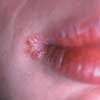- Clinical Technology
- Adult Immunization
- Hepatology
- Pediatric Immunization
- Screening
- Psychiatry
- Allergy
- Women's Health
- Cardiology
- Pediatrics
- Dermatology
- Endocrinology
- Pain Management
- Gastroenterology
- Infectious Disease
- Obesity Medicine
- Rheumatology
- Nephrology
- Neurology
- Pulmonology
Angular Cheilitis Caused by Staphylococcus aureus and Linear Epidermal Nevus
A verrucous birthmark, a rash at the commissure of the lips, proximalnail changes--can you identify the disorders pictured here?

Case 1:
Irritation at the angle of the lips on the right side bothers a 14-year-old boy. The rash failed to respond to an antifungal cream prescribed by another practitioner. The patient has been using isotretinoin for acne for 3 months.
Which of the following do you suspect?
A. Resistant candidal infection.
B. Contact dermatitis to lip balm.
C. Contact dermatitis to toothpaste.
D. Staphylococcal infection.
E.
Irritation caused by a vitamin deficiency.
Your next step is to . . .
F. Recommend more frequent use of lip balm.
G. Recommend a change in the brand of oral hygiene products used.
H. Prescribe a different topical antifungal.
I. Order a bacterial culture.
J. Prescribe vitamin B12 supplements or injections.

Case 1: A culture of material from this patient's lip, I, confirmed an angular cheilitis caused by Staphylococcus aureus, D. A Candida infection can mimic this bacterial condition; if the patient's disease fails to respond to antifungal therapy, mupirocin cream may be tried or a bacterial culture can be performed.
Contact dermatitis to oral hygiene products usually produces a circumferential swelling around the vermilion border of the lips. The eruption caused by a vitamin B12 deficiency typically is bilateral.
Most likely, isotretinoin-induced dryness of the lips predisposed this patient to cheilitis, as well as to the staphylococcal infection. The patient was advised to use lip moisturizer, F, regularly. Mupirocin cream quickly cleared the infection. The patient has had no further episodes.

Case 2:
A 26-year-old man requests evaluation of a birthmark on his scalp that has remained essentially unchanged. He is particularly concerned about the absence of hair in and around the lesion.
What are you looking at here?
A. Nevus sebaceus.
B. Nevus comedonicus.
C. Shagreen patch.
D. Linear epidermal nevus.
E. Lichen striatus.
What are the treatment options for this condition?
F. Trial of topical minoxidil.
G. Cryosurgery.
H. Shave excision.
I. "Comb-over" technique.
J. Hair transplantation.
Case 2: This patient has a linear epidermal nevus, D. These nevi, which appear as single or multiple lesions, may be present at birth or appear up to age 10 years. The lesion typically has a verrucous surface.

Nevus sebaceus is a flat orange or yellow-brown plaque that typically thickens as a result of hormonal activity at puberty; punch biopsy can be used to distinguish linear epidermal nevus from nevus sebaceus. Nevus comedonicus appears as linear comedones. The shagreen patch is a connective tissue nevus associated with tuberous sclerosis; the texture is similar to that of fine-grained leather. Lichen striatus is a papular eruption that usually appears on a lower limb in children; it typically resolves spontaneously within a year.
Treatment options for linear epidermal nevus include cryosurgery, G, and shave excision, H; however, recurrences are possible. Full-thickness surgical excision is the definitive treatment.
Unlike nevus sebaceus, linear epidermal nevus is not thought to have the potential to become malignant.

Case 3:
A 62-year-old man, who is currently being evaluated for weight loss and malaise of a few months' duration, has noted changes to all of his nails during the past 6 weeks. The proximal half of the nails has become rough, while the distal portion remains normal. The patient is taking a b-blocker for hypertension and esomeprazole for gastroesophageal reflux disease.
Which of the disorders in the differential is the likely cause of the nail condition?
A. Psoriasis.
B. Paraneoplastic nail changes.
C. Lichen planus.
D. Trauma.
E. Sudden weight loss.
Case 3: The complete workup revealed a GI adenocarcinoma; this finding supported the suspected diagnosis of paraneoplastic nail changes, B, a rare condition that can occur with any malignancy.

Nails that are affected by psoriasis typically have an oil-slick appearance, pitting, and subungual debris. Lichen planus can produce the rough-textured nail changes seen in this patient and needs to be considered in the differential. If necessary, a biopsy of a nail can confirm the diagnosis.
Trauma commonly causes distal nail changes, such as those seen in nail biters. Sudden weight loss, hospitalization, and surgery may lead to temporary interruption of natural nail growth, which can cause a transverse groove in the nail. When the provoking event is over, affected nails regrow normally.
